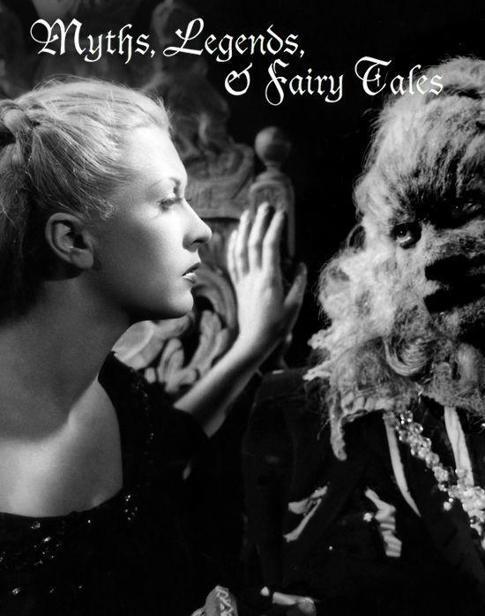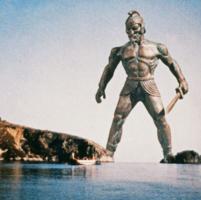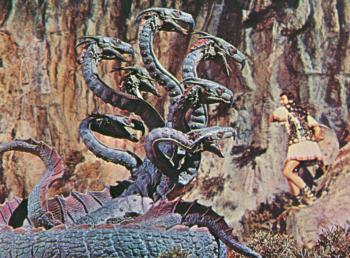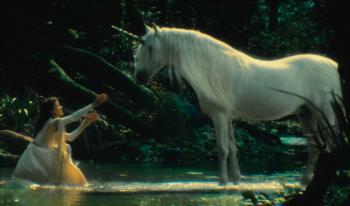GDT They have a sort of purging effect. For a while, they allow you to believe in the supernatural in a stupidly rational world.
JL: Why do you think the audience for these films is mostly young people?
GDT: Because I think that horror movies destroy the illusion of order and sanity in the world. Order and sanity is a very adult concern. No one knows better the fragility and vulnerability of the real world than kids. At its worst, horror is a very repressive genre. But at its best, it’s an incredibly anarchic and iconoclastic one. Kids identify with that.
JL: Muchas gracias, mi amigo!
GDT: You are more than welcome!

Belle (Josette Day) soothes the savage Beast (Jean Marais) in Jean Cocteau’s classic fairy tale adaptation La Belle et la Bête.
MYTHS, LEGENDS, & FAIRY TALES
The world’s myths, legends, and fairy tales have provided the movies with a plethora of monsters. Walt Disney introduced many of us to folk and fairy tales in his beautifully animated movies. In fact, the first ever feature-length, animated film is Disney’s Snow White and the Seven Dwarfs[1937].
As captivating as Snow White is, it is the jealous and wicked Queen we all remember. The elegant and sensual Queen who turns herself into an Old Crone to give Snow White the poisoned apple was unforgettably voiced by an uncredited Lucille La Verne. Disney’s films were often genuinely scary, as in Sleeping Beauty[1959], when actress Eleanor Audley gave voice to the evil fairy Maleficent’s splendid line: “Now you must deal with me and all the powers of Hell!” as she magically transforms into a gigantic fire-breathing dragon to do battle with the dashing Prince.
The delightful Disney version of Carlo Collodi’s classic book The Adventures of Pinocchio[1881], released as Pinocchio[1940], was also not without its dark side. The sequence when Pinocchio and his friend Lampwick’s bad behavior causes them to “make asses of themselves” and they turn into donkeys, is as startling and sinister as any transformation scene in a werewolf movie.
The traditional French fairy tale “Beauty and the Beast” has been made into a number of movies. The best one is Jean Cocteau’s magical La Belle et la Bête[1946]. The Beast, played by Jean Marais, is so glorious, that at the “happy ending,” his metamorphosis into the handsome human prince is a bit of a let-down. The Disney Beauty and the Beast[1991] is a full-on operetta, with witty songs by Howard Ashman and Alan Menken and outstanding voice work by Paige O’Hara as Beauty and Robby Benson as the Beast.
The Irish fairies known as leprechauns have starring roles in movies in which they are good, like the charming Darby O’Gill and the Little People[Robert Stevenson, 1959] and movies where they are evil, like the series of films that started with Leprechaun[Mark Jones, 1993]. Warwick Davis has played the malicious little magical bastard in six Leprechaun films so far, with no end in sight! Davis has also written an entertaining autobiography called Size Matters Not[Arum Press, 2010], in which he talks about his little person roles in countless fantasy films, including Willow, Star Wars, Harry Potter, and more.
Elves and dwarfs feature in all of The Lord of the Ringstrilogy of films [Peter Jackson, 2001, 2002, 2003]. Based on the books by J. R. R. Tolkien, the trilogy contains thousands of fantasy beings including giants, trolls, fairies, wizards, ambulatory talking trees, demons, goblins, and an army of Orcs. Through a powerful motion-capture performance by Andy Serkis, the emotionally tortured creature Gollumstands out from the rest of the extraordinary array of mythical characters on display.
The one-eyed giants called Cyclops show up occasionally in films based on both Greco-Roman and Arabian Nights mythology. My favorites are the incredible Cyclops that live on the Island of Colossa in Ray Harryhausen’s first feature film shot in color, The 7th Voyage of Sinbad[Nathan H. Juran, 1958]. I saw this movie at the age of eight and it changed my life in the same way that the original King Kong[Merian C. Cooper, Ernest B. Schoedsack, 1933] changed Harryhausen’s (see my conversation with Ray on pages 148-9). I was enchanted, not only by the impressive Cyclops, but also by the fabulous dragon, and especially the skeleton brought to life by the wicked magician Sokurah (played in a wonderfully hammy turn by Torin Thatcher). Towards the beginning of the film, Sokurah turns the Princess’ handmaiden into a dancing Snake Woman, Ray’s favorite monster from this particular voyage of Sinbad’s.
Harryhausen took Sinbad on two more voyages, The Golden Voyage of Sinbad[Gordon Hessler, 1973] and Sinbad and the Eye of the Tiger[Sam Wanamaker, 1977], both movies adding even more mythological monsters to the Harryhausen menagerie, including ghouls, a one-eyed centaur, a griffin, and a multi-armed statue of Kali that comes to life to sword-fight Sinbad and his crew.
The poet Homer gave us the Cyclops in the Odyssey, and Ulysses[Mario Camerini, 1955] starring Kirk Douglas in the title role, is a good retelling of the hero’s epic voyage to his homeland of Ithaca following the fall of Troy. An Italian wrestler named Oscar Andriani plays the Cyclops, who is tricked by wily Ulysses into getting drunk so that once more we can watch a poor Cyclops have something sharp jammed into his only eye. Also based on Greek mythology is Jason and the Argonauts[Don Chaffey, 1963], which allowed Harryhausen to create more of his remarkable creatures to illustrate the story of Jason and his quest for the Golden Fleece. On Jason’s adventure, we meet the colossal bronze statue Talos, brought to life by the hubris of Hercules, the flying Harpies sent to torment the blind Phineas for misusing his gift of prophecy, the many-headed Hydra who guards the Golden Fleece, and the “Children of the Hydra’s teeth”—screaming skeleton warriors. The Gods themselves watch Jason’s adventures from Mount Olympus and occasionally intercede on his behalf (as Hera does by sending the sea god Triton to hold back the Clashing Rocks, enabling Jason’s ship Argoto pass through unharmed).
Harryhausen’s final foray into Greek myth was the story of Perseus, told in Clash of the Titans[Desmond Davis, 1981]. Here, Pegasus the flying horse, giant scorpions, the snake-haired Medusa, and the Kraken compete for our attention. The movie was remade in 2010 [Louis Leterrier] with CG effects and mediocre 3D. But at least we got to hear once more those delicious words: “Release the Kraken!”
Myths, Legends, & Fairy Tales[ Book Contents]
Jason and the Argonauts [Don Chaffey, 1963]
Talos, the gigantic Man of Bronze that comes to life when Hercules takes a javelin-sized pin from the treasure he guards. Ray Harryhausen’s animation is extraordinary as Talos somehow moves as a Man of Bronze would move. Here, Talos, like the ancient Colossus of Rhodes, waits to grab Jason’s ship, Argo.

Myths, Legends, & Fairy Tales[ Book Contents]

Jason (Todd Armstrong) fighting the Hydra, the seven-headed dragon that guards the Golden Fleece. Another scene lit up by Harryhausen’s breathtaking stop-motion animation.
Myths, Legends, & Fairy Tales[ Book Contents]
Legend [Ridley Scott, 1985]
Princess Lily (Mia Sara) reaches out to a unicorn in Scott’s beautiful-looking fairy tale.
